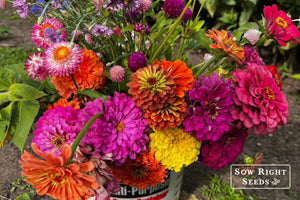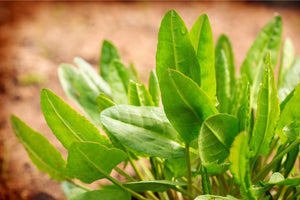Timing is Everything: How and When to Plant Pumpkin Seeds for the Perfect Fall Harvest
PumpkinsPumpkin is delicious in pies, muffins, and other baked goods any time of year. However, if you are aiming to have pumpkins ready for Halloween and Fall decorations, it is important to consider the timing. Our pumpkin growing guide provides valuable information on when to plant to achieve the perfect fall harvest.

Pumpkins are a deliciously healthy vegetable. Like other hard-skinned winter squash, pumpkins can be stored whole, roasted, made into purées, frozen, and canned. Whether you use them for ornamentals or flavor, planning ahead is necessary. With the right timing, you'll know when you can plant your seeds and have ripe, cured pumpkins for jack-o-lantern carving, fall decor, and fresh pumpkin pie.
Choose Your Pumpkin Varieties
To choose a pumpkin variety, consider your interests and garden space. For gigantic pumpkins, plant Big Max , but make sure you have enough room. For a unique decor pumpkin, try Galeux d’Eysines. If you want a sweet variety for pies, go for the Small Sugar Pumpkin. You can learn more about the different heirloom pumpkin varieties here.

When to Plant Pumpkin Seeds
When planting pumpkins, timing is everything, especially if you want to have them ready for Halloween or to use in fall decor.
With harvesting considerations in mind and the pumpkin growing conditions, you won’t plant pumpkins in many locations until June or even July. However, you also need to consider the first fall frost.
Pumpkins are a warm-weather crop and are not frost tolerant. Therefore, they shouldn’t be planted until the daytime temperatures are above 70ºF and the nights are frost free. You will also want to make sure that the pumpkins have enough time to grow to maturity before the first fall frost. Again, timing is everything.
To time your pumpkin harvest, consider what day you want to display or use your pumpkins. Then, count back 10 to 14 days for curing time. Then, count back the number of days needed for the pumpkins to grow to maturity. (You can skip curing time if you will be eating or using them right away and not storing them.)
For example, if you are growing the blue-gray Jarrahdale pumpkin, it takes 95 days to grow to maturity. Let’s say you want to have it ready to display on October 7. We’ll count back 14 days for curing and then 95 days to reach maturity. This means you could plant a Jarrahdale pumpkin as late as June 20 and as early as April 20. (If you want to store it for 2 months.)
If you are growing multiple pumpkin plants, you can also stagger the planting if desired to give you options for harvesting. Or you can plant them all at the same time to have one harvest.
How to Plant Pumpkin Seeds
Getting the soil ready
Like most plants, getting the ground ready is vital for growing healthy produce. Pumpkins need a lot of nutrients to reach their full potential. So preparing the soil before planting will get you off to a successful start. Add aged compost and rich organic matter to the soil before planting pumpkins. The optimal soil pH is 6 to 6.8.
Sowing pumpkin seeds
Pumpkin seeds are best sown directly in the garden after the soil has warmed up. Plant pumpkin seeds 1 inch deep in 3-foot wide mounds. You can plant 3 to 4 seeds per mound and then thin to only 2 plants per mound - keeping the most viable plants.
Starting pumpkin seeds indoors can give you a few more weeks to grow if needed. When starting pumpkin seeds indoors, keep the soil temperature between 70 and 80ºF. Start seeds indoors 3-4 weeks before the last spring frost.
Keep pumpkin seeds moist until they have germinated, which should take 7 to 14 days, depending on the soil temperature.
When transplanting the pumpkin seedlings, they should have about 4 mature leaves and well-developed roots.
How to Grow Pumpkins
To reach their maximum potential, pumpkins need plenty of water, the right amount of fertilizer, and room to grow.
Watering pumpkins
Pumpkins need a lot of water. At a minimum, they’ll need an inch of water per week. Soaker hoses and drip irrigation are excellent watering methods as they will keep the ground wet for the roots and leave the pumpkins and leaves dry.
The leaves on pumpkin plants will often wilt on hot summer days, but they should perk back up at night. If they do not, then the pumpkin plants need more water.
Fertilizing pumpkins
Pumpkins are heavy feeders, so they need additional applications of fertilizer. Use a fertilizer formulated for vegetable growing.
Room to grow pumpkins
Pumpkins need room to spread. The bigger the pumpkins, the bigger the vines. Give pumpkin plants enough room to grow. As they spread their vines, you can gently move them to grow away from other plants in your garden.

Additional pumpkin growing tips:
- Hand pollinating can be very beneficial due to weather etc. During the day, when the flowers are open, take a paintbrush and gather pollen from the male flowers, and transfer it to the female flowers.
- Pumpkins can rot if left on moist soil. However, placing a layer of straw or cardboard can create a dry barrier.
- To grow bigger pumpkins, you can thin back the developing pumpkins to only a few per plant.
- Lay down black plastic and cut out holes for each plant. This method keeps out weeds and warms up the soil.
- If you want to grow enormous pumpkins, you can remove other female blossoms once you have the few pumpkins you want to keep growing to maturity.
Solutions for pumpkin pests and diseases
Cucumber beetles and squash bugs can be a menace to pumpkin plants. However, the use of floating row covers can protect the plants.
Companion planting is also a helpful control method.
To prevent diseases that come from moist conditions, water around the plant, and not on the leaves or at the base. Keep the water 1 to 2 feet out from the plant stem.

Harvesting Pumpkins
Let the fun begin! Harvesting pumpkins is the best part. Now you can use them for all your fall decor plans and in your favorite recipes.
When pumpkins are ripe, the rinds will be hard, and the color should be the right shade for their mature size. This color is different for each variety. Some are bright orange, others are pale, and some are white.
The stem will be hard and shriveled. Also, the rind will be hard and not easily dented by a fingernail.
Cut the pumpkins from the vine with a sharp knife or pruning shears. Leave a long stem so that the pumpkin will last longer. When picking up pumpkins, lift them from below instead of the stem. If the stem breaks off, the pumpkin will start rotting sooner.
Harvest pumpkins before the first fall frost.
Pumpkins need to be cured before being stored long-term. To cure pumpkins, leave them in the sun for 10 to 14 days. During this time, they need to stay dry. So, if necessary, you can place them indoors.
Store pumpkins with space between them and a humidity of 50 to 60 percent.
Pumpkins will last in storage for 2 to 3 months under the right conditions.
Pumpkin Growing FAQs
The flowers are falling off, but there aren’t any pumpkins.
First, check the flowers to see whether they are male or female. The male flowers will fall off after only a few days. The female flowers should have a small fruit behind the flower. If these flowers are falling off, it means they aren’t getting pollinated. You can do hand pollinating if needed.
Can you transplant pumpkins?
Pumpkin seeds can be started indoors and then transplanted outdoors as seedlings.
How long do pumpkins take to grow?
Each pumpkin variety takes a different amount of time to grow to maturity. The overall range can be 90 to 160 days. Smaller varieties will take less time to grow than big pumpkins.
Can I plant seeds from a pumpkin?
You can plant seeds from an heirloom pumpkin! However, the seeds need to be fully mature to be able to germinate.
When do I plant pumpkins?
You can plant pumpkins as soon as it is warm enough for them to grow without danger of frost. This means daytime temperatures are above 70ºF and the nights are frost free.
Are you ready to have all those pumpkin seeds turn into beautiful pies? Or do you want some decorative, white, blue-gray colors for decor? And how about a bright orange pumpkin for Halloween carving? So many options with pumpkins!
Plan now, and you'll know when to plant pumpkin seeds for your fall pumpkin harvest.
2 comments
Popular Posts
-

It’s Not Too Late! 12 Summer Flowers You Can Plant in June
-

Easy Guide to Growing Sorrel from Seed – Annual or Perennial Success







Pumpkin seeds can be planted fresh out of the pumpkin. But if it’s not time to plant, you will want to let the seed dry so it won’t rot before it’s time to plant. You can read more about saving heirloom seeds. https://sowrightseeds.com/blogs/planters-library/how-to-save-the-seeds-from-your-favorite-plants
My question was can you plant pumpkin seeds right out of the fresh pumpkin or do you have to dry them first. Your information didn’t answer this question. Thanks!
Leave a comment